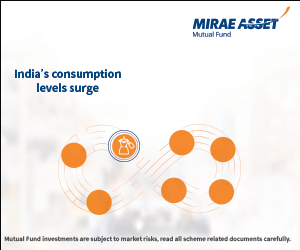In our view credit risk is rather permanent whereas market risk is temporary
BFSI Industry Interview

Mr. Mahendra is responsible for managing fixed income assets across all products. He has over 25 years of experience in the field of financial services including 11 years of experience in Fixed Income funds management. He is overall responsible for supervising all Debt schemes of the Mirae Asset Mutual Fund. Key funds managed by him include Mirae Asset Savings Fund, Mirae Asset Dynamic Bond Fund and Mirae Asset Cash Management Fund.
Prior to this assignment, Mr. Jajoo was Director with AUM Capital Markets Ltd. He has also been associated with organizations like Pramerica Asset Managers Pvt. Ltd., Tata Asset Management Ltd., ABN AMRO Asset Management Ltd and ICICI Group.
What is your outlook on the bond market and yields in the light of the fiscal deficit policy announced by the FM in Budget 2021?
India’s fiscal deficit for FY21 is now projected at 9.50%, much higher than market expectation in 7.5-8% range. Moreover, budget gap for FY22 is also projected rather higher at 6.8% of GDP. Though with enhanced allocation to capital expenditure and inclusion of many off balance sheet items, like part of food subsidy, in earlier years into the main budget document provides higher transparency and a more realistic projection, it also implies higher market borrowings for current year. With estimated nominal GDP growth at 14.4%, this year’s gross borrowings remain on higher side at Rs 12.06 lakh crores, around previous year level. With economic growth keeping pace, this may lead to crowding out of private sector borrowing and put pressure on the yields. However, on positive side, India has recovered fairly well from this covid crisis, while the other nations still struggle with the second wave of the pandemic. With subdued growth prospects, developed nations central banks would likely continue with easy monetary policy that will provide RBI extra elbow room to maintain accommodative stance. Not having to face a strong second wave has helped India have stable macro-economic environment. Thus, for now, with headline inflation having eased to 4.10% in January’21, interest rates may remain range bound for now with issue largely being supply management that RBI with sustained intervention through open market operations can smoothen out. While rapid recovery and the growth pickup in the domestic economy may result in yields inching up in the latter half of the year, the stable macro-economic environment will keep check on the extreme volatility.
What is your outlook on spreads for corporate bonds?
In 2020, the combination of easy liquidity and record low cost borrowing were key for many companies to make it through the pandemic. But as the high frequency data suggest India is expected to bounce back strongly this year, which would induce the RBI to cut back the on stimulus. It has already given its first hint by announcing variable reverse repo operation and restoring of CRR gradually. However, as indicated by high frequency data the growth is here to bounce back and this is likely to increase the credit growth into the economy. Taking into consideration that borrowings are going to be higher by government as well as corporates the spreads are likely to widen going ahead proving a good opportunity for investors to lock in higher yields and attractive spreads.
Are there attractive investment opportunities in corporate bonds, particularly high quality papers? Which segment(s) of the corporate yield curve are attractive from investment standpoint?
The high-quality papers have gained importance since NBFC crisis and maybe even before that. The markets have always performed in medium to long term whereas the damage from the credits have been more or less permanent. In continuation with the above view the spreads are likely to widen due to credit pickup, this should create some good opportunities for investing. Keeping in view that there could be resurgence in inflation, it would be prudent to remain invested in 3-5 years segment.
You are launching Mirae Asset Corporate Bond Fund NFO. For the benefit of retail investors and financial advisors, please describe the salient features of this scheme?
The Key features are as under:
Mirae Asset Corporate Bond Fund NFO will predominantly invest in Corporate Bonds rated AA+ and above, with some exposure to Government Securities and T-Bills
The fund will investment across the yield curve but target Modified Duration will be within range of 2-5 years based on interest rate outlook
The fund will follow an active portfolio management based on flexible interest rate strategy.
Fund does not prefer investing in lower rated papers (AA and below) and perpetual bonds at the moment and focus will be to create a high quality portfolio based on our credit assessment process
This category has the potential for better risk adjusted returns compared to other debt fund categories and traditional fixed income instruments. Also debt funds benefit from taxation benefits if holding period is more than 3 years
Though corporate bond funds invest primarily in the high quality bonds, for the benefit of investors please describe the processes you have in Mirae for managing credit risks on an ongoing basis?
In this context it is important to reiterate that in our view credit risk is rather permanent whereas market risk is temporary. Most of the fund investments are planned into the companies available in the public domain and that have a tangible source of cash flow generation. Also, the investments are being targeted in plain vanilla structures and to avoid any structured deals. As far as the investment universe construction is concerned it is done out of the available set of issuers present in the markets for the issuances in accordance with and suitable to the fund / scheme strategy. For evaluation, each and every issuer has to pass through the Internal Rating Model, which on the basis of quantitative (financial risk) as well as qualitative factors (business risk), provides a rating to the respective issuer. Financial risk is measured using a set of ratios focusing on profitability, liquidity, cash flow and debt protection capabilities. Business Risk includes analysis of six parameters i.e. strategic direction, financial philosophy, conservatism, track record, succession planning and control system. Also, a credit approval note is prepared for each & every issuer, which, apart from the internal rating model, consists of the Company description, SWOT analysis, business review & industry review. Further, the investment universe is reviewed regularly on a quarterly basis along with their annual review on the basis of annual results.
Though investors in India prefer to invest lump sum in debt funds, can investors look at the SIP route for investing in Mirae Asset Corporate Bond Fund. What are your views?
SIP fit into any plan of investing surpluses regularly and protect them from entry points. Debt investing is already linked as a defensive form and adding SIP in debt investing makes it more systematic and disciplined. Thus SIP is not only considered to be good in corporate bond fund but any debt scheme.
What is your advice for investors wanting to invest in the corporate bond fund? What should be the risk profile? What is advice about minimum investment tenure which investors should plan while investing?
Corporate bond fund is a good choice for investors looking for a debt options with reasonable returns with good safety. The corporate bond fund will generally have exposure to highly rated papers keeping the risk for investors reasonably low. Investors who can remain invested for 3+ years will enjoy the benefits of long-term capital gains taxation thereby improving their post-tax returns on investment.
For further details on Mirae Asset Corporate Bond Fund, Please visit https://www.miraeassetmf.co.in/
Mutual fund investments are subject to market risks, read all scheme-related documents carefully.
Recent Interviews
-
In conversation with Mr Vaibhav Shah Head Products: Business Strategy & International Business Mirae Asset Mutual Fund India
Apr 18, 2025
-
In conversation with Mr Kaustubh Sule Senior Fund Manager Fixed Income with Groww Mutual Fund
Apr 18, 2025
-
In conversation with Mr Abhishek Tiwari Chief Business Officer of PGIM India Mutual Fund
Apr 5, 2025
-
In Conversation with Mr Akhil Chaturvedi Executive Director & Chief Business Officer with Motilal Oswal Mutual Fund
Mar 26, 2025
-
In conversation with Mr Rohit Seksaria Fund Manager Equity with Sundaram Mutual Fund
Mar 7, 2025
Fund News
-
Axis Mutual Fund joins ONDC Network to Expand Access to Mutual Fund Investments
Apr 18, 2025 by Axis Mutual Fund
-
Nippon India Mutual Fund launches Nippon India Nifty 500 Quality 50 Index Fund
Apr 18, 2025 by Advisorkhoj Team
-
Nippon India Mutual Fund launches Nippon India Nifty 500 Low Volatility 50 Index Fund
Apr 18, 2025 by Advisorkhoj Team
-
RBI Monetary Policy: RBI changes policy stance and lowers rate
Apr 9, 2025 by Axis Mutual Fund
-
Kotak Mahindra Mutual Fund launches Kotak Nifty Top 10 Equal Weight Index Fund
Apr 7, 2025 by Advisorkhoj Team




